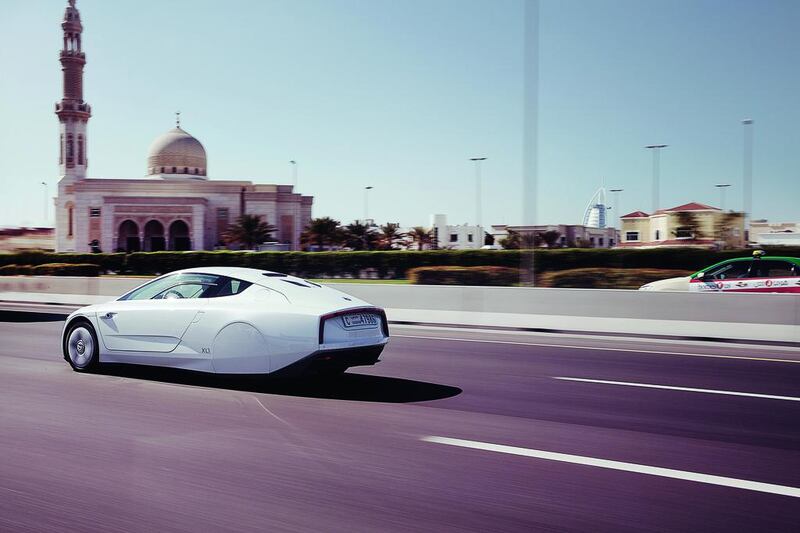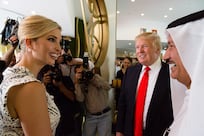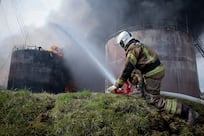The United Arab Emirates is full to bursting with supercars. Name a piece of modern exotica and, chances are, you’ll see one valet-parked outside a shopping mall or tearing down a motorway at terrific speed. Either that or being posed in along JBR Walk in Dubai, where the pace is so slow that the drivers are usually overtaken by pedestrians. The Dubai police use Bugattis, Lamborghinis, Ferraris and all the rest. But even they haven’t got one of these and, yes, it is a supercar, but not as we know it.
Volkswagen’s XL1 has all the trappings of a supercar. It’s extremely low, with a roof that just about reaches your hips when you’re stood next to it. It has its turbocharged engine mounted amidships, just behind the heads of its occupants — just like every proper supercar. Its shape is slippery, to slice through the air with the minimum of resistance. It has only two seats and is outrageously impractical. At around Dh600,000, it’s expensive. It’s rare, too, with only 200 planned for production. It’s formed out of carbon fibre-reinforced polymer (lighter and stronger than steel, so it’s incredibly safe) and other exotic materials like magnesium and, crucially for this supercar paradise, it turns heads like only an alien spacecraft could. It’s a supercar in every sense. Or is it?
There are two very important differences between the XL1 and what we in this region would deem to be a supercar. Firstly, there’s the small matter of performance. The XL1’s engine is powered by diesel fuel and it’s basically half of that fitted to Volswagen’s diminutive Polo. That’s right, it’s possessed of only two cylinders, which together displace a frankly puny 800cc (or 0.8L). The other difference is in its consumption. The XL1, thanks to its design, construction and hybrid powertrain, uses less than one litre of fuel every 100km.
This, ladies and gentlemen, is officially the world’s most economical production car and it’s here. Here as in Dubai right now; here as in you can waltz into a Volkswagen showroom and actually order one yourself.
Andreas Keller was one of the engineers who’s been with the project since its inception at the behest of Ferdinand Piëch, the former head of the Volkswagen group, back in 1998. He’s in Dubai to act as product specialist and guardian, meaning that nobody can drive it on public roads without him in the passenger seat, and he’s clearly very proud of what Volkswagen has achieved.
“In many respects, this car is similar to the Bugatti Veyron,” he says. I shoot him a quizzical look. “I mean in that it’s the absolute pinnacle of engineering that we as a company are capable of right now. It’s an extreme car, it’s just that it’s the opposite of the Veyron. But the technology and the design are equally important.”
Actually, once production of the XL1 stops next year, it will be rarer than a Veyron, which won’t cease being built until 450 cars have been sold. The Veyron’s design genius lies in its ability to warp the space-time continuum and still be able to be driven by your grandmother. It’s a true trailblazer, but how many others could continue in its wake? I can’t think of any right now. But the XL1 demonstrates so much radical technology that could actually reach future production cars that it merits our close attention. This is a veritable science laboratory on wheels and even Piëch (who, incidentally, also came up with the Veyron concept) thought his dream of a “one-litre” car was impossible, resigning himself to perhaps one that could, instead, travel for 100km on two litres of fuel. The finished result easily trounces his initial demands.
At The National, we take every opportunity to champion cars that do less damage to our precious planet and that’s why I’m here, on a rather warm Dubai morning, being shown around an example of the car that could change the way we see automobiles forever.
It’s tiny. I mean minuscule on a scale I’ve never before seen on a car that can accommodate two normal-sized adults. Its frontal area alone is only two-thirds of that occupied by a Polo and the rear is even narrower. Keller explains that this “teardrop” shape, which tapers rearward, makes for a more aerodynamic profile — the XL1 boasts a drag coefficient of 0.189. When Audi introduced its 100, back in 1980, it was (if only one door mirror was fitted) the world’s most aerodynamic production car, with a figure of 0.30. And, while these figures won’t mean much to the average motorists, they do make a whole heap of difference to the way a car drives and consumes.
I made mention earlier of the year this project was started: 1998. When the formidable Piëch threw down the gauntlet, the company’s designers and engineers immediately set about producing a carbon-fibre bodied special with tandem seating and a single-piston engine. In 2002, he drove to a VW shareholders meeting in Hamburg in the prototype, in his last public appearance as chairman, and even then managed to beat the fuel-consumption target that he had set his engineers. But still he could not foresee a time when a car like this could be produced for customers.
He’d proved a point, however, and after he left his job, the project was basically forgotten about. Eventually, however, Piëch’s replacement, Martin Winterkorn, along with Volkswagen’s head of R& D, Ulrich Hackenberg, revisited it and developed the twin-cylinder hybrid L1, which appeared at the Frankfurt Motor Show in 2009. Hackenberg had, by then, rejected the tandem seating as unattractive to buyers, but Piëch came up with the idea of a staggered arrangement, to limit the width increase that would have resulted from a normal seating arrangement.
Keller says that the XL1 project has been honed and refined with the input of potential customers, so the finished result has a better chance of finding the required number of buyers. And it’s a stunning machine, no matter where I look.
The seats themselves are made from the same stuff as the body: carbon fibre. Which means that they’re light and very strong. The cabin is quite austere yet stylish. “There had to be some creature comforts,” says Keller, “but we’ve done everything possible to keep the weight down. The air conditioning, for instance, is powered by a smaller unit than is usual, so it might get a bit hot in there during the UAE’s summer. Also, the gearbox, which is a twin-clutch automatic, has been rehoused in a magnesium casing because it’s incredibly light — the entire car only weighs 795 kilograms. The tyres are narrow to keep down the rolling resistance and the rears are covered by wheel spats that aid streamlining. You will also notice there are no exterior mirrors.”
He’s right. There’s nothing to hamper the XL1’s aerodynamic efficiency, but mirrors are somewhat essential for driving on public roads. “There are two rear-facing cameras fitted into either side of the car,” he explains, “and the real-time images are fed to screens in the doors.” It’s remarkable stuff — far beyond the imaginations of the most fervent science-fiction devotees. If it could take off vertically and hover above ground instead of using those narrow tyres, I would believe it. It can’t but, then again, that technology is probably just around the corner.
But here and now, the XL1 can be used on the road. Any road. So it’s time to see how it drives and what the people of Dubai think of it.
As with some other hybrid cars, when you switch on the XL1 it makes no sound, so long as there’s at least 50 per cent charge in its on-board battery pack. Unlike other hybrids, however, there’s absolutely no wind noise thanks to that uncluttered exterior. It’s surreal, like gliding.
When the engine does cut in, which is not very often, it emits some rather strange sounds, partly because of the fuel source, but this simply adds to the sense of wonder while piloting it. And, speaking of wonder, that’s what’s evidently on the minds of anyone who sees us. Drivers swerve even more than usual as they (stupidly) try to get a shot on their mobile phones. Kids point and stare; a bus full of construction workers sounds its horn and its occupants look on, amazed, as though we’ve just landed from another planet. It’s scary being the centre of so much attention, but it’s understandable, and when we finally come to a rest the crowds keep swarming, asking questions, taking more photos, posing in front of it and trying to peek inside. If a Veyron pulled up alongside now, nobody would give it a second glance — the XL1 makes everything look ordinary.
The sense of theatre is simply heightened by opening its doors. They’re hinged on the upper A-pillars and swing upwards on gas struts — anything else would have been a total let-down. The driving experience is no let-down, either, with reassuring steering feel (Keller says that power assistance adds weight — and anyway it didn’t need it, with such narrow wheels and low weight) and the car nips around with ease, despite its on-paper drivetrain specification deficiencies. It’s easily up to the task of urban driving, although it sits incredibly low to the road surface and I wouldn’t fancy negotiating the UAE’s more severe speed humps in it.
But we simply cannot compare the XL1 to any other car. It is Volkswagen’s interpretation of what the future could possibly look like and shows us all that, despite the naysayers and the environmentalists lambasting the car industry, the automobile has exactly that: a future.
And that future has arrived.
[ khackett@thenational.ae ]
It’s unfortunate that, in this part of the world, there’s scant interest in fuel-efficient vehicles. Cars that consume the least also happen to (usually) be small and that goes against the grain with most motorists here, who seem perfectly content with cars that are as big as houses. They’re also powered by small engines, often fuelled by diesel — a fuel that few even know about here — or they’re hybrids like the XL1, mixing small engine efficiency with battery power to offer drastic fuel savings.
Are you still awake? Good, because it’s high time that we looked at the way in which we consume the planet’s precious resources and how we pollute the air that we all share. And our choice of car reflects the values that we have as individuals. If we actually care about our impact on the world, we won’t be driving huge and thirsty vehicles. We just won’t.
The solution
How, then, are manufacturers getting around the problem of marketing their more responsible offerings? Toyota has supplied hybrid cars to at least two of Dubai’s taxi-fleet operators, saving many tonnes of airborne carbon dioxide in the process, while its luxury arm, Lexus, has started positioning its hybrids as the top-of-the-range models, stuffed to the gunnels with lots of delicious technology.
Did you know that even Porsche is testing the waters here with its diesel and hybrid Cayennes and Panameras? Volkswagen, too, has been trialling diesel models and is analysing feedback from customers and the media as an evaluation on whether or not to bring them here as part of its permanent range.
BMW, as you will read in Weekend’s regular Motoring pages this week (turn to page 15), will be selling its i8 supercar here very soon.
These are all small steps, granted, but they are in the right direction. The more that we see and hear about fuel-efficient transport, the more that it will become a natural thing for us to consider — the impact that we each have on the world that we all inhabit.
Doing your bit
Even if we’re not in the market for a new car, there are things we can do to make our existing vehicles more efficient.
Keeping tyres at the correct pressures, smooth inputs with our brakes and accelerators, gentler driving styles and regular servicing — everyone benefits from these things.
Change is inevitable, no matter how we look at it. It’s just that the tide has been turning against the car for some time now and, against all the odds, it might just survive thanks to the innovative efforts of the people who design and build them.
* Kevin Hackett






